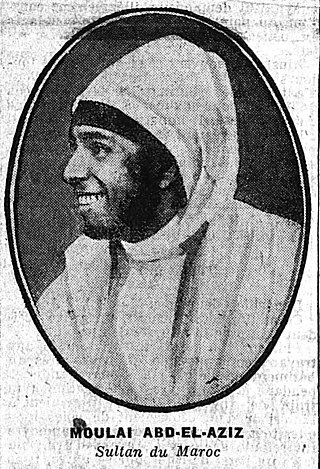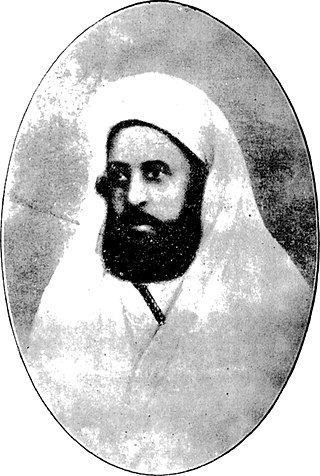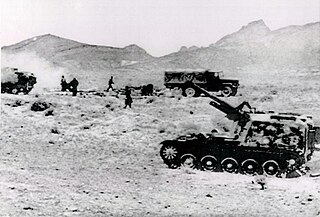
French Algeria, also known as Colonial Algeria, was the period of Algerian history when the country was a colony and later an integral part of France.
The Zenati languages are a branch of the Northern Berber language family of North Africa. They were named after the medieval Zenata Berber tribal confederation. They were first proposed in the works of French linguist Edmond Destaing (1915) (1920–23). Zenata dialects are distributed across the central Berber world (Maghreb), from northeastern Morocco to just west of Algiers, and the northern Sahara, from southwestern Algeria around Bechar to Zuwara in Libya. The most widely spoken Zenati languages are Tmazight of the Rif in northern Morocco and Tashawit Berber in northeastern Algeria, each of which have over 3 million speakers.

The Mzab–Wargla languages or Northern Saharan oasis dialects are a dialect cluster of the Zenati languages, within the Northern Berber subbranch. They are spoken in scattered oases of Algeria and Morocco.

MoulayAbd al-Aziz bin Hassan, born on 24 February 1881 in Marrakesh and died on 10 June 1943 in Tangier, was a sultan of Morocco from 9 June 1894 to 21 August 1908, as a ruler of the 'Alawi dynasty. He was proclaimed sultan at the age of sixteen after the death of his father Hassan I. Moulay Abdelaziz tried to strengthen the central government by implementing a new tax on agriculture and livestock, a measure which was strongly opposed by sections of the society. This in turn led Abdelaziz to mortgage the customs revenues and to borrow heavily from the French, which was met with widespread revolt and a revolution that deposed him in 1908 in favor of his brother Abd al-Hafid.

Béchar is a province (wilaya) in Algeria, located on the border with Morocco in the Algerian Sahara. It is the second least-densely populated province in Algeria. Its capital and biggest city is Béchar.

MawlayHassan bin Mohammed, known as Hassan I, born in 1836 in Fes and died on 9 June 1894 in Tadla, was a sultan of Morocco from 12 September 1873 to 7 June 1894, as a ruler of the 'Alawi dynasty. He was proclaimed sultan after the death of his father Mawlay Muhammad bin Abd al-Rahman. Mawlay Hassan was among the most successful sultans. He increased the power of the makhzen in Morocco and at a time when so much of the rest of Africa was falling under foreign control, he brought in military and administrative reforms to strengthen the regime within its own territory, and he carried out an active military and diplomatic program on the periphery. He died on 9 June 1894 and was succeeded by his son Abd al-Aziz.

The Sand War was a border conflict between Algeria and Morocco fought from September 25, 1963 to October 30, 1963, although a formal peace treaty was not signed until February 20, 1964. It resulted largely from the Moroccan government's claim to portions of Algeria's Tindouf and Béchar provinces. The Sand War led to heightened tensions between the two countries for several decades.

Tuat, or Touat, is a natural region of desert in central Algeria that contains a string of small oases. In the past, the oases were important for caravans crossing the Sahara.
The 19th Army Corps was a corps of the French army. In December 1870, the Tours delegation created the 19th Army Corps which was formed in Alençon. It was recreated by decree of the JO of August 13, 1874, it brought together the various military units of Algeria. It constituted the nucleus of the Army of Africa.

The French conquest of Algeria took place between 1830 and 1903. In 1827, an argument between Hussein Dey, the ruler of the Regency of Algiers, and the French consul escalated into a blockade, following which the July Monarchy of France invaded and quickly seized Algiers in 1830, and seized other coastal communities. Amid internal political strife in France, decisions were repeatedly taken to retain control of the territory, and additional military forces were brought in over the following years to quell resistance in the interior of the country.

The French conquest of Morocco began with the French Republic occupying the city of Oujda in 29 March 1907. The French launched campaigns against the Sultanate of Morocco which culminated in the signing of the Treaty of Fes and establishment of the French Protectorate in Morocco on 30 March 1912. France later concluded, on the 27th November, the Treaty of Madrid with the Kingdom of Spain which established the Spanish protectorate in Morocco. The French still conducted a series of military operations to pacify rebellions in Morocco until 1934.

The Ait Atta are a large Berber tribal confederation of South eastern Morocco, estimated to number about 330,000 as of 1960. They are divided into "five fifths", all said to descend from the forty sons of their common ancestor Dadda Atta: these "fifths" are the Ayt Wallal, Ayt Wahlim, Ayt Isful, Ayt Yazza and Ayt Unbgi. They speak Tachelhit and Central Atlas Tamazight..

The Battle of El Herri was fought between France and the Berber Zaian Confederation on 13 November 1914. It took place at the small settlement of El Herri, near Khénifra in the French protectorate in Morocco. The battle was part of the Zaian War, in which the confederation of tribes sought to oppose continued French expansion into the interior of Morocco. Having captured the strategic town of Khénifra earlier in the year, the French, under General Hubert Lyautey, entered negotiations with Mouha ou Hammou Zayani, who led the Zaian. Lyautey thought that peace could be achieved and ordered Lieutenant-Colonel René Laverdure, who commanded the garrison in Khénifra, not to launch any offensives.

The pacification of Algeria was a series of military operations after the French conquest of the Regency of Algiers that aimed to put an end to various tribal rebellions, razzias and massacres of French settlers that were sporadically held in the Algerian countryside. The conflict was an early example of unconventional warfare.

The Battle of El-Moungar was a battle fought during the South-Oranese Campaign between a contingent of the French Army of Africa, mainly from the French Foreign Legion, and Moroccan tribesmen.
General Antoine Jules Joseph Huré was a French army officer and engineer noted for his service in Morocco. Huré joined the army as a volunteer in 1893 and after training at the École Polytechnique and École d'Application de l'Artillerie et du Génie he was commissioned into the 3rd Regiment of Engineers. He spent a number of years with his regiment and on staff appointments in France before transferring to Algeria first with the 19th Army Corps, and then the 15th Army Corps. In 1912 Huré transferred to the general staff in eastern Morocco and earned the Colonial Medal.
There exists in Algeria many regions. Whether they are cultural, linguistic, historical, or geographical in nature, none are recognized as an administrative unit by the Algerian government. With regards to the administrative structuring of the country, Algeria is divided into 58 wilayas or provinces.

The conflicts between the regency of Algiers and the Cherifian dynasties or Algerian-Sherifian conflicts are, within the framework of the conflicts opposing Morocco to the Ottoman Empire and its dependencies, a series of wars between, on the one hand, the regency of Algiers and its allies - the local sultanates or tribal confederations - and, on the other hand, the Cherifian Saadian and Alawite dynasties that have ruled Morocco since the 16th century.

The Algeria–Morocco border is 1,427 km (887 mi) in length and runs from Mediterranean Sea in the north, to the tripoint with Western Sahara in the south. The border has been officially closed to all travel since 1994, although clandestine crossings are common.

Si El Madani El Glaoui, born Madani El Mezouari El Glaoui, nicknamed the faqih was a prominent statesman in Morocco during the late 19th century and early 20th century. He was largely responsible for establishing the Glaoui family's power in the country.















